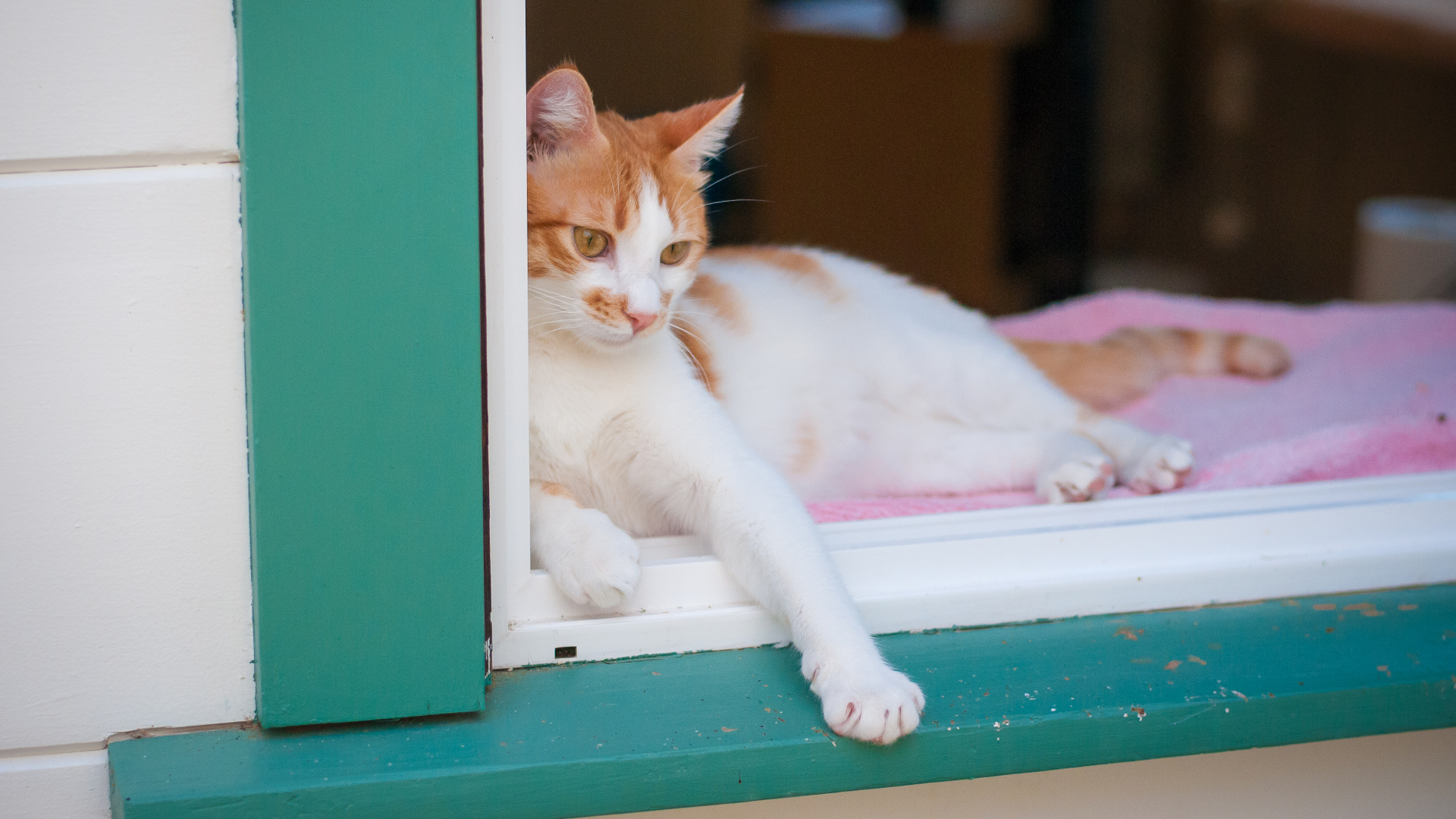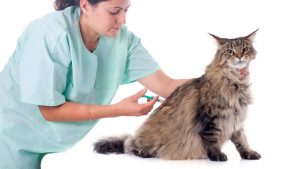Provided by the Cornell Feline Health Center, Cornell University
What is diabetes mellitus?
Diabetes mellitus-also known as “sugar” diabetes-is a complex but common disease in which a cat’s body either doesn’t produce or doesn’t properly use insulin. During digestion, the fats, carbohydrates, and proteins that are consumed in the diet are broken down into smaller components that can be utilized by cells in the body. One component is glucose, a fuel that provides the energy needed to sustain life.
Insulin is a hormone produced in the pancreas, is responsible for regulating the flow of glucose from the bloodstream into the cells of the body. When insulin is deficient or ineffective, the cat’s body starts breaking down fat and protein stores to use as alternative energy sources. As a result, the cat eats more yet loses weight. Additionally, the cat develops high levels of sugar in the bloodstream, which is eliminated in the urine. In turn, sugar in the urine leads to excessive urination and thirst. Cat owners often notice these four classical signs of diabetes mellitus: ravenous appetite, weight loss, increased urination, and increased water consumption.
Diabetes mellitus is generally divided into two different types in cats: insulin-dependent diabetes mellitus (IDDM)], and non-insulin-dependent diabetes mellitus (NIDDM)]. Approximately one-half to three-quarters of diabetic cats have and thus require insulin injections as soon as the disease is diagnosed. The rest have NIDDM; however, most ultimately require insulin injections to control their disease.
While diabetes mellitus can affect any cat, it most often occurs in older, obese cats. Male cats are more commonly afflicted than females. The exact cause of the disease in cats is not known, although obesity (the major predisposing condition), chronic pancreatitis, other hormonal diseases (e.g., hyperthyroidism, Cushing’s disease, and acromegaly), and certain medications (e.g., megestrol acetate and corticosteroids like prednisolone) have all been linked to the disease. Burmese cats in New Zealand, Australia, and the United Kingdom are prone to developing to diabetes, but this doesn’t appear to be the case in North America.
How is diabetes diagnosed?
Diabetes mellitus is diagnosed based on the cat’s signs, physical examination findings, laboratory test results, and the persistent presence of abnormally high levels of sugar in the blood and urine. Once diabetes has been diagnosed, immediate treatment is necessary.
Left untreated, diabetes will shorten a cat’s lifespan. A dangerous, sometimes fatal condition called ketoacidosis may develop, indicated by loss of appetite, vomiting, diarrhea, lethargy, weakness, dehydration, and breathing abnormalities. Additionally, diabetes can lead to an unhealthy skin and coat, liver disease, and secondary bacterial infections. A diabetes-related disorder called diabetic neuropathy may cause cats to become progressively weaker, especially in the hind legs, impairing their ability to jump and causing them to walk with their hocks touching the ground.
Diabetes treatment is based on the severity of the disease. Cats with ketoacidosis require prompt intensive care, which usually includes fluid therapy and short-acting insulin injections. For cats that are not severely ill, your veterinarian may recommend a treatment plan that includes insulin injections or oral medications, along with dietary changes.
What is involved in treating a diabetic cat at home?
Each diabetic cat is an individual, and each responds differently to treatment. Some diabetic cats are easy to regulate; others are not. Some can be treated with oral medications, while others require insulin injections. Some cats’ diabetes is transient-reversing course with the passage of time-while others will require treatment for the remainder of their lives. Different cats respond best to different types of insulin. Regardless of this variability, all diabetic cats do best with consistent medication, consistent feeding, and a stable, stress-free lifestyle.
Insulin
Most diabetic cats require insulin injections administered under their skin twice daily. The injections can be given at home, preferably at the same time each day. Your veterinarian will show you how to give these injections, which are not painful-in fact, most cats are unaware that the injection is being given. Because each is different, the proper type of insulin, dose, and frequency of administration needs to be determined by your veterinarian. Ideally, this is based on an 18- to 24-hour blood glucose profile, obtained through a veterinarian-administered insulin injection and subsequent testing of blood sugar levels at regular intervals throughout the day. Insulin dosage may change with time and may need to be adjusted based on new blood glucose profiles, the results of intermittent blood tests and urine sugar measurements, and the cat’s response to therapy.
Oral Hypoglycemic Medications
Healthy diabetic cats can sometimes be successfully treated with glipizide, an orally administered hypoglycemic medication that lowers blood glucose. Adverse side effects, although uncommon, include vomiting, loss of appetite, and liver damage. If you use glipizide, have your cat’s glucose levels checked regularly to verify medication’s efficacy. Although glipizide works for some diabetic cats, most require insulin injections to successfully control their disease. In addition, the administration of oral medication on a long-term basis is difficult for many cats and their owners; insulin injections may be a better choice for them.
Diet
In addition to medication, an important step in treating diabetes is to alter your cat’s diet. Obesity is a major factor in insulin sensitivity, so if your cat is overweight, you will need to help him lose weight gradually. Your veterinarian can tailor a safe weight-loss program, in which your cat loses weight gradually. A high-fiber, high-complex carbohydrate diet not only can achieve weight loss if necessary, but is believed to help control blood sugar levels after eating. (Underweight cats should initially be fed a high calorie diet until they reach their ideal body weight.) Other diabetic cats respond well to carbohydrate-restricted diets. Although diabetic cats have been successfully managed with both types of diets, some cats respond better to high-fiber diets and others to low-carbohydrate diets. Trial and error can help determine the best diet for your cat.
Your cat’s feeding routine is also important. While many cats are “free-choice” feeders (i.e., food is left out for them to eat whenever they want), this may not be the ideal routine for a diabetic cat. Ideally, a cat receiving insulin should be fed half its daily food requirement at the time of each injection, with the unconsumed remainder available throughout the day. The timing of feedings is less critical for cats receiving glipizide; nevertheless, food intake should be closely monitored.
What are the potential complications of treating a diabetic cat?
Hypoglycemia-low blood sugar-is a potentially dangerous complication, usually caused by a relative overdose of insulin. Hypoglycemia signs include weakness, listlessness, lack of coordination, convulsions, and coma. Left untreated, hypoglycemia can be fatal. If hypoglycemia develops, the cat should immediately be offered its normal food. If the cat is unable to eat, rub some corn syrup onto the gums or, if the cat can swallow, slowly administer it by syringe into the mouth. Never force fingers, food, or fluids into the mouth of a convulsing or comatose cat. Contact your veterinarian immediately for further instructions if your cat exhibits signs of hypoglycemia.
How do I monitor my diabetic pet?
Monitoring your diabetic cat is a joint effort between you and your veterinarian. Because your cat’s insulin requirements may change over time, periodic checking of blood glucose or serum fructosamine levels is essential. Seek veterinary treatment at the first reappearance of diabetes signs (increased thirst, increased weight loss, increased appetite, or increased urination).
Some cat owners are willing and able to take on the task of measuring their cat’s blood glucose levels at home rather than in a veterinary hospital-a potentially less expensive and more accurate monitoring method. Ask your veterinarian whether home glucose testing might be suitable for you and your cat. More information can be found online at www.sugarcats.net/sites/harry/bgtest.htm.
At home, you’ll need to be constantly aware of your cat’s appetite, weight, water consumption, and urine output. It is important to feed a consistent amount and type of food at the same times each day, so that you can be aware of days that your cat either does not eat or is unusually hungry after the feeding. Additionally, since water consumption is highly variable from one cat to another, monitoring your cat’s water consumption for a few weeks will allow you to establish what is normal for your cat. Urine output can be roughly estimated by determining the amount of litter that is scooped out of the litter box. This is less accurate if more than one cat uses the litter box, but changes can still be meaningful. Any significant variation in your cat’s food intake, weight, water intake, or urine output can be a sign that the diabetes is recurring and immediate veterinary care is needed.
What is the prognosis for a diabetic cat?
There is no cure for diabetes mellitus. However, some diabetic cats may lose the need for insulin, months or years after diagnosis. If diabetes has resulted from obesity, it is likely to improve a great deal-or even completely resolve-once the cat’s weight is under control. If obesity or some other disorder is not a factor, the diabetes probably will not go away; however, it can be successfully managed. The serious chronic complications that afflict people with diabetes mellitus (such as kidney disease, blood vessel disease, and coronary artery disease) are uncommon in diabetic cats. Once control is attained with proper treatment and home care, a diabetic cat can live many healthy years. Nonetheless, successfully managing a diabetic cat requires much dedication and communication between you and your veterinarian.








